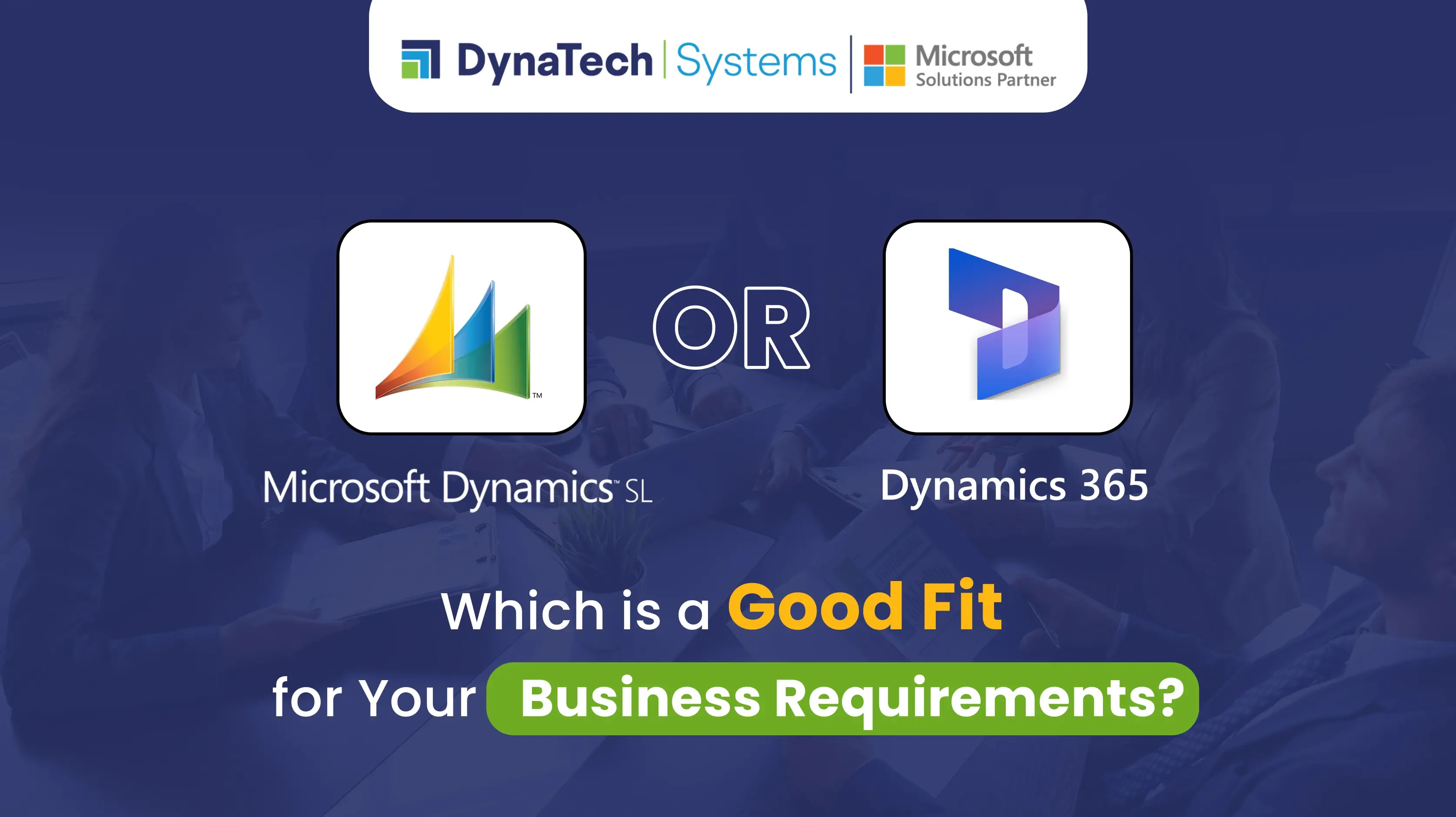Microsoft Dynamics SL and Microsoft Dynamics both have their own set of benefits and limitations. However, sometimes, businesses cannot obtain the maximum advantage from these ERP platforms. The fact is that companies are probably not fully aware of which ERP system fits well with their requirements.
Hence, today, we are going to answer and clear all the questions and doubts that are often raised when it comes to choosing between Microsoft Dynamics SL and Dynamics 365.
In this blog, we will be describing in detail both Microsoft Dynamics SL and Dynamics 365. Let’s get the basics cleared first:
What is Microsoft Dynamics SL?
Microsoft Dynamics SL, formerly known as Solomon, is an ERP solution designed specifically for mid-sized businesses. to streamline their financial operations and other projects. It is best for project-based industries like government, contracting, construction, and professional services.
Additionally, Dynamics SL provides a set of valuable tools for financial management, budgeting, project accounting, and reporting. These tools are best suited to monitoring overall project costs, managing cash flow, and adhering to compliance and industry standards.
Market Overview of Microsoft Dynamics SL
Let’s check out some surprising figures related to Microsoft Dynamics SL to understand its market foothold:
About 40% of Dynamics SL users are in professional services industries such as project-based businesses, government contracting, and construction.
Microsoft Dynamics SL has been rapidly moving toward cloud-based deployments. As of recent reports, more than 40% of new Dynamics SL implementations are now in the cloud, primarily through Microsoft Azure.
Microsoft Dynamics SL commonly sees high customer satisfaction ratings (typically in the range of 4 to 4.5 stars out of 5 on multiple software review platforms like G2 and Capterra). Users often highlight the system’s capability to manage project accounting, job costing, and financial reporting.
Key Features of Dynamics SL
Let’s check out the prime features of Microsoft Dynamics SL for a better understanding and complete optimization of its efficiency:
1. Project Management and Accounting
Microsoft Dynamics SL tracks project costs, budgets, revenues, and billing in real time. It also supports multiple contract types, such as fixed-price contracts and time-and-materials.
2. Budgeting and Forecasting
This enterprise resource planning software enables businesses to generate comprehensive budget plans and forecasts. It’s done by monitoring actual performance against financial objectives for both operations and projects.
3. Financial Management
It allows businesses to smoothly manage their key financial functions like general ledger, cash management, accounts payable/receivable, and multi-currency support for global operations.
4. Inventory and Supply Chain Management
This software allows you to manage inventory along with procurement and purchasing by offering real-time data into stock levels and ensuring seamless management of project material.
5. Time and Expense Tracking
This software has the ability to simplify the entry and approval of time and expenses. This helps businesses to bill clients or allot costs to specific projects.
6. Reporting and Analytics
Microsoft Dynamics SL offers customizable financial and project reports with super-efficient tools to examine core metrics like profitability and project performance.
What is Microsoft Dynamics 365?
Microsoft Dynamics 365 is an extensive cloud-based suite of enterprise resource planning (ERP) and customer relationship management (CRM) applications created to allow businesses to automate and simplify their processes. It offers capabilities for sales, finance, customer service, supply chain management, human resources, and others into a single unified system by providing real-time insights and AI-driven analytics.
With the effortless integration of Microsoft products like Power BI and Office 365, Dynamics 365 supports seamless collaboration, drives efficiency, and helps businesses make data-driven decisions. Additionally, its modular design allows organizations to deploy specific applications that consider their requirements and scale as they evolve.
Market Overview of Microsoft Dynamics 365
Let’s check out some surprising figures related to Microsoft Dynamics SL to understand its market foothold:
Nearly 80% of Dynamics 365 users are now harnessing the cloud-based version of the platform, primarily through Microsoft Azure, due to its scalability, security, and integration capabilities.
Dynamics 365 consistently receives high ratings from users, with an average rating of 4.5/5 stars on review platforms like G2 and Capterra.
Businesses using Dynamics 365 have seen an average 15% increase in sales and a 10% improvement in operational efficiency, according to various industry reports and case studies.
95% of Dynamics 365 users report utilizing Microsoft 365 (Office 365, Teams, etc.) along with Dynamics 365, obtaining ample benefits from smooth integration for collaboration and productivity.
Key Features of Microsoft Dynamics 365
Let’s check out the prime features of Microsoft Dynamics 365 for a better understanding and complete optimization of its efficiency:
1. Modular Design
Microsoft Dynamics 365 is a flexible, scalable platform that provides multiple modules such as Sales, Finance, Customer Service, and Supply Chain Management. This helps organizations to go for the functionalities they actually require and expand as they evolve.
2. Improved Customer Interactions
Dynamics 365 offers tools for streamlining and automating sales processes, managing customer interactions, and generating targeted marketing campaigns which allows organizations to improve customer engagement and drive sales performance.
3. Streamlined Business Processes
This platform comprises core financial and operational tools like managing accounting, inventory management, budgeting, and procurement processes, helping businesses simplify their workflow and optimize financial and supply chain operations.
4. Artificial Intelligence and Analytics
Dynamics 365 harnesses the power of AI and machine learning to provide predictive insights, automate decision-making processes, and help with real-time analytics through integrations with Power BI. This enables businesses to make more informed, data-driven decisions.
5. Collaboration and Integration
As Microsoft Dynamics 365 effortlessly integrates with Office 365 and Azure cloud services, this significantly enhances collaboration across different departments. Also, it enables real-time access to essential data from anywhere.
6. Automation and Workflow
With built-in process automation and the capability to design custom workflows, Dynamics 365 helps organizations easily automate their regular tasks, simplify operations, and enhance efficiency by minimizing manual efforts.
7. Customization and Extensibility
Businesses can personalize Dynamics 365 to meet their particular requirements by creating custom applications with Power Apps, as well as accessing a marketplace of third-party add-ons for improved functionality.
Points of Differences Between Microsoft Dynamics SL and Microsoft Dynamics 365
Let’s check out the key points of differences between Microsoft Dynamics SL and Microsoft Dynamics 365 to clearly understand which fits your requirements:
|
Feature |
Microsoft Dynamics SL |
Microsoft Dynamics 365 |
|
Deployment Model |
It is essentially designed for on-premises deployment with cloud hosting options |
It is a fully cloud-based solution by default with hybrid deployment options |
|
Target Audience |
Dynamics SL is for small to medium-sized organizations, specifically in project-based industries like construction and services |
Dynamics 365 is for businesses of all sizes, across multiple industries (retail, finance, healthcare, etc.) |
|
Feature Set |
Prime focus is on project accounting, job costing, financials, and contract management |
It offers an extensive suite combining ERP and CRM for different business processes |
|
Customization and Flexibility |
Can be personalized but less flexible than Dynamics 365 |
It is completely customizable with tools like Power Apps and extensive integration options |
|
Cloud Integration and Updates |
Limited cloud integration, less frequent updates |
Completely cloud-based with regular automatic updates and integration with the Microsoft cloud ecosystem |
|
User Interface |
Legacy, less intuitive interface |
Modern, intuitive, responsive interface across multiple devices |
|
Business Intelligence & Analytics |
Basic reporting and financial analysis |
Advanced analytics with Power BI integration and AI-powered insights |
|
AI and Automation |
Limited AI and automation features |
AI-driven features for sales, customer insights, forecasting, and process automation |
|
Global Reach and Scalability |
Primarily used in the U.S. and English-speaking regions, limited scalability |
Available in over 60 countries, supporting multiple languages and currencies |
|
Cost Structure |
Generally, it’s more budget-friendly for SMBs |
It can be more expensive for small-sized and mid-sized businesses, it’s generally suitable for larger organizations |
|
Support and Community |
Smaller community, lesser support resources |
Large community with extensive support, resources, and documentation |
To Wind Up
We hope the information this article has covered will help you decide which platform to opt for considering your business requirements. Both Microsoft Dynamics SL and Microsoft Dynamics 365 are best in their ways and fit well to specific business needs. And now that you have given this article a thorough read, we are sure you can easily choose the best platform for you.
For more technical support, you can always reach us out! Being an official partner of Microsoft Dynamics 365, we can fulfill all your business requirements optimizing the efficiency and excellence of D365. Contact us to discuss how we can make your future promising with the help of Microsoft Dynamics 365.




























